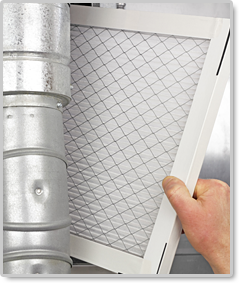Guide to Choosing & Changing HVAC Air Filters

Why Is It Important To Change Your Furnace Air Filter?
Changing your furnace’s air filter is important for two reasons: 1) A dirty air filter makes your furnace’s blower motor work harder, which wastes energy. Changing your air filter can save you up to $50/year in energy savings; and 2) Over time, your furnace’s air filter gets clogged with the particles that it is made to take out of the air, and as such, as it gets dirty it can’t do its job of cleaning the air in your home.
How Often Should You Change Your Furnace Air Filter?
The frequency of when you should change your air filter can range between once every month, to once every 3 months, and for your particular home it will depend on several factors:
-
If you have someone in you family that has respiratory problems, such as allergies or asthma, then you will want to change your furnace’s air filter more often.
-
If you have a high level of particulates from pets, smoking, construction projects, etc., then you will want to change your air filter more often.
-
The recommended frequency will also depend on the efficiency of the filter that you use. Higher efficiency filters do a better job of removing smaller particles from the air, but they also get clogged faster, and therefore need to be changed more often.
How To Choose the Right Furnace Air Filter?
Similar to how often you should change your filter, the choice of the right air filter for your particular home and living situation depends on a number of factors.
The first thing to consider in choosing the right filter is knowing its size. To find the size of the filter you need, just check on the side of the current filter that is in your furnace. Most filters will have the size written right on them (see types, costs, and reviews of furnace air filters). However, if you have any doubts as to whether the correct size was originally installed, then it is best to check with your furnace’s manufacturer.
The next thing to consider in choosing the right filter for your home is the MERV rating of the filter. MERV ratings are used to rate the ability of an air filter to remove dust, pollen, mold spores, bacteria, etc. from the air as it passes through the filter. MERV ratings range from 1 to 16, and the higher the MERV rating, the smaller the particle that the filter can trap. Some of the most common filters found in residential use only have a MERV rating of between 1 to 4. These are relatively inexpensive, but they do NOT do a good job of filtering the air, because they will not stop particles smaller than 10 microns. Filters with MERV ratings of between 5 to 8 are a better choice, and these filters will catch particles as small as 3 microns. Filters with a MERV rating of 9 to 12 will stop particles in the 1 to 3 micron range, and these filters are a great choice for homeowners who want the best particle control possible. And finally, the most efficient filters have MERV ratings of 13 to 16 and will stop particles as small as .3 microns. These filters are used in hospitals and other super-clean environments.
IMPORTANT: If you decide to use a high efficiency air filter with a MERV rating of 9 or higher, then it is very important that you remember to check the filter each month (which is easy to remember if you have signed up for your free reminders from Home-Wizard.com!) and replace the filter if it looks dirty, otherwise it can become blocked and cause your furnace blower to have to work harder, which will cost you more energy to operate it. So don’t get higher MERV rating filters unless you are sure that you will be replacing them often.
The various types of filters include: electrostatic, pleated, HEPA and activated carbon. Some are disposable and some are washable. But what really matters is the MERV rating, as described above.
How To Do-It-Yourself?
Replacing your furnace air filter is one of the easiest do-it-yourself tasks there is, once you learn how. Here is a short YouTube video that shows the typical location of your furnace filter and how to replace it: replace furnace filter
And here are the steps to follow for replacing your furnace filter:
Step 1: Find out where your existing filter is located and read the size that is written on the side of it.
Step 2: Decide what MERV rating is appropriate for your home situation (see above).
Step 3: Purchase your filter. You might want to consider buying enough to last you the entire year, so you have them available as needed, without having to make extra trips or online orders.
Step 4: Turn off your furnace. This is best to do right at the breaker, but you can also do it at your thermostat.
Step 5: You will want to check the existing filter to see which direction the “air flow” arrow is pointing on it, as you will want to install the new filter in the same direction. Most filters will have an air flow arrow printed right on it. However, if you are not 100% sure the direction is correct (for example if you have just moved into the home), then you can do what is called the “string test”: tie a string firmly to your finger, then turn your furnace blower on; next, bring your finger with the string on it near the opening where your filter opening is, and see which direction the air causes the string to flow . . . and this is your air flow direction. Just be sure to tie the string FIRMLY to your finger, so it doesn’t get sucked inside your furnace!
Step 6: Remove your old filter.
Step 7: Install your new filter, with the proper air flow direction.
Step 8: Write the current date on the side of the new filter (in case you forget when it was changed).
Step 9: Clean up any dust, debris, etc. around your furnace.
Step 10: Turn your furnace back on.
Hopefully this article has helped you understand why you should change your air filter; how often to do it; how to choose the right filter; and how to do-it-yourself.
Related Articles . . .
Furnace Tips for Efficiency & Safety
The cost of heating your home can be up to one-third of your home's energy bill. This article and video gives you 21 tips for saving money, improving safety, and extending the useful life of your furnace.
Guide to Choosing & Changing HVAC Air Filters
For saving energy and improving air quality, changing the air filters for your furnace is important. This article discusses: why you should change your air filter; how often to do it; how to choose the right filter; and how to do-it-yourself.
Preparing Your Home For Winter
Winter can be very hard on both your home and your pocketbook. This article gives you a checklist of things you can do to both protect your home, and to help reduce your energy bills this winter.
Low-Cost Ways to Save Energy This Winter
Some energy-saving projects take several years to pay back the cost of doing them. But here are six ways to save energy this winter, that will save you more than their cost in just one heating season!
Protecting Your Outside Water Faucets in Winter
If you live in a region where temperatures outside can go below freezing in the winter, this article and video shows how and why you should shutoff and drain the water completely out of your outside spigots before the winter.









